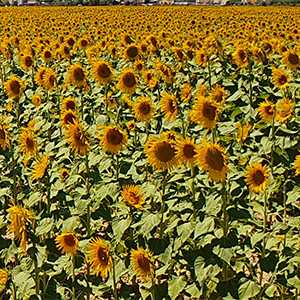Agronomic response of sunflower subjected to biochar and arbuscular mycorrhizal fungi application under drought conditions

Accepted: 18 August 2022
HTML: 250
All claims expressed in this article are solely those of the authors and do not necessarily represent those of their affiliated organizations, or those of the publisher, the editors and the reviewers. Any product that may be evaluated in this article or claim that may be made by its manufacturer is not guaranteed or endorsed by the publisher.
There is growing interest in developing environment-friendly farming practices that can limit the impact of drought stress in agriculture. The main objective of this study was to investigate the combined effects of biochar and arbuscular mycorrhizal fungi (AMF) on the agronomic responses of sunflower. Field experiments were conducted in the 2018 and 2019 growing seasons in semi-arid environments of Iran. The following treatments were adopted: i) three levels of biochar [0, 2.5 and 5 t ha–1 of biochar called Bl, Bm and Bh, respectively]; and ii) three irrigation levels (50, 30 and 10% of the maximum available water (MAW) called 50MAW, 30MAW and 10MAW, respectively)]; iii) two levels of AMF inoculation (with and without the addition of AMF called +AMF and –AMF, respectively). The experimental design was a randomized complete block design. At flowering, the leaf area index (LAI) was generally higher in the plants subjected to Bh-+AMF (on average 4.95), even if the LAI values changed according to biochar application (Bh > Bm > Bl) and the level of irrigation (50MAW > 30MAW > 10MAW). At harvesting, sunflower seed yield was highest in +AMF and in Bh (on average 53.9 and 51.2 g plants–1, respectively). Sunflower plants subjected to Bh-+AMF showed the highest seed yield under all irrigation levels (79.4, 57.1 and 32.3 g plant–1 in 50MAW, 30MAW and 10MAW, respectively). The application of biochar combined with AMF resulted in an increase in agronomic responses compared to untreated plants (Bl- –AMF) such as root biomass (+15%), stem diameter (+12%), plant height (+5%) and head diameter (+15%). Seed protein was higher in +AMF than –AMF (on average 20.7 vs 17.2 g m–2, respectively) and in Bh and Bm compared with Bl (on average 19.4 vs 18.2 g m–2, respectively). The oil content of seeds was affected by biochar application and AMF inoculation, especially under 50MAW and 30MAW irrigation levels; conversely, no differences were observed under the 10MAW irrigation level. Sunflower yield characteristics were positively correlated to the net photosynthesis rate and negatively affected by hydrogen peroxide and malondialdehyde content. The results showed that the adoption of biochar and AMF may represent as a successful strategy to balance crop productivity in a semi-arid environment. Although further research is required for a better understanding of the irrigation and fertilization schedule, these preliminary results could be extended to other crops which have similar requirements to sunflower.
Highlights
- The combined effects of biochar and arbuscular mycorrhizal fungi on sunflower are studied.
- Biochar application and mycorrhiza inoculation improved plant performance.
- Biochar and AMF positively affected the net photosynthesis rate of sunflower plants.
- The adoption of biochar and AMF may mitigate the effect of drought conditions.
- Biochar and AMF can support sunflower cultivation.
How to Cite

This work is licensed under a Creative Commons Attribution-NonCommercial 4.0 International License.
PAGEPress has chosen to apply the Creative Commons Attribution NonCommercial 4.0 International License (CC BY-NC 4.0) to all manuscripts to be published.

 https://doi.org/10.4081/ija.2022.2086
https://doi.org/10.4081/ija.2022.2086







